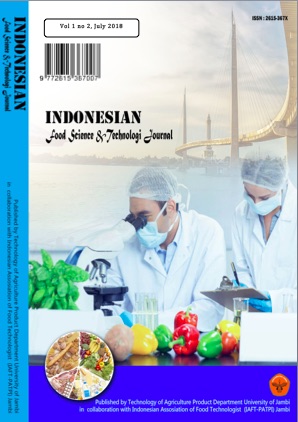Comparative Analysis of Flour Properties of Dioscorea alata Tuber And Its Utilization On Wet Noodle
DOI:
https://doi.org/10.22437/ifstj.v1i2.5342Abstract
Abstract— Dioscorea alata grown in many areas of the world has been intensively studied. However none of Indonesian cultivar has been intensively studied for their properties and its utilization in food industry. This research was aimed to compare the properties of purple Dioscorea alata’s flour produced using different methods and to study the effect of partly substituted wheat by purple Dioscorea alata’s flour on the characteristic of wet noodles. The research on the properties of purple Dioscorea alata’s flour was conducted using complete random design with treatment on the methods used to produce flour: control, steaming, soaking in 1% citric acid solution + steaming, blanching + soaking in 1% citric acid solution + steaming and blanching + soaking in 2% ascorbic acid solution + steaming.These 5 methods were repeated 4 times. The research on utilization of Dioscoreaalata’s flour on wet noodle was conducted using complete random design with 5 levels of treatment (0%, 10%, 20%, 30%, and 40% of Dioscorea alata’s flour) and 4 replications. The result showed that steaming the slices of tuber for 7 minutes prior to drying was an effective method to produce flour with strong natural color of purple. The concentration of Dioscorea alata’s flour significantly affects the elongation and texture of noodle (p<0.05). Except for its unpleasant grey color, wet noodle can be produced using up to 40% Dioscorea alata’s flour.
Downloads
Downloads
Published
Versions
- 2019-07-21 (1)
- 2019-07-21 (1)
How to Cite
Issue
Section
License
Copyright (c) 2018 Indonesian Food Science & Technology Journal

This work is licensed under a Creative Commons Attribution 4.0 International License.







